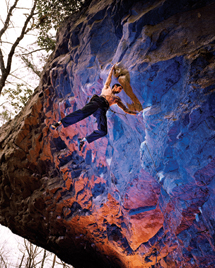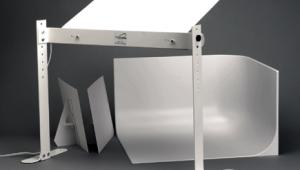Big Difference; When Everyone Else Was Switching To Digital, Andrew Kornylak Was Hauling Medium Format Up The Mountain
In most cases when we talk to climbers who photograph or photographers who
climb, we start out by asking which came first, the climbing or the photography.
About 75 percent answer the former. Then we ask why they climb. The answer is
usually some variation of "it's a thrill." And then, why they
photograph, which brings a variation of "to capture the thrill."
The first questions we had for Andrew Kornylak were different. "Why do
you climb with those cameras?" we asked. Followed by, "And those
lights?"
Andrew, you see, took medium format to the mountain. Several medium format cameras,
actually. Over the years he toted a Rolleiflex 6x6 twin lens, a Mamiya 645,
a Mamiya 7 II, and a Mamiya 645 AF.
 |
|
|
And some major-league lighting. When handle- and shoe-mount strobes proved
inadequate for the caves and big rock faces he wanted to light, he rented location
kits--Lumedynes, Hensels, Comets, JTLs. Then he bought a 300 watt-second
JTL monolight and a portable battery system. Then even more lights: White Lightning
units and the Vagabond system that powers them. All told he was carrying about
120 lbs of gear stuffed into as many bags as it took to hold it all, with those
bags packed into giant, expedition-style duffels from his climbing days. It
took two or three trips, all by lifting power, to get the gear from the truck
to the rock. "But if you've been climbing a long time," Andrew
says, "chances are you're used to carrying a lot of junk out to
remote places. I had the practice."
The lights we get, but medium format? Well, obviously for the larger chromes
and negs they produce and the added detail they capture. But also for business;
call it the larger presence they denote.
"I'd been experimenting with some medium format equipment, but was
shooting almost all my climbing with 35mm," Andrew says. "It was
the classic gear to use. Then one day I was shooting side by side with a well-known
climbing photographer and I asked him if anyone shoots climbing with medium
format. He said no, and I was surprised. I knew that fashion and wedding photographers
used medium format to shoot people in motion, and I knew medium format creates
different possibilities for framing, too. I got really excited about shooting
medium format for climbing. It was part creative and part business--medium
format was a way for me to differentiate myself in the marketplace." This
was about the time that a lot of pro shooters were turning from 35mm to digital
SLRs, and Andrew did get a digital SLR, but medium was the message he wanted
to deliver to his clients.
 |
"As soon as I started shooting medium format for the same stuff I shot
with 35 and saw the huge negs and chromes, I was hooked," he says. "I
shot prints and transparencies, and I set up to scan medium format." He
usually sent clients the scans as previews and the originals for reproduction.
"They saw the format," he says, "and the detail it provided.
And they got more information to work with if they wanted to crop."
So, did medium format turn out to be a selling point for his photography? Yes
and no. "In some cases it was," he says, "and in other cases
the clients couldn't have cared less; they were much more interested in
the subject than the format." Overall, though, he thinks it did help him
stand out, at least to some of his clients.
About those standard questions, it turns out that Andrew is among the 25 percent.
Photography was in his life before climbing, thanks to his father and grandfather,
who were both amateur photographers. "I was used to seeing a lot of cool
camera equipment around the house," he says. And thanks also to his older
brother, who was a newspaper photographer for several years before giving it
up for law school, a move that resulted in Andrew getting the world's
best hand-me-down: his brother's pro camera. When an interest in climbing
came along during Andrew's first year in college, it was natural for him
to take cameras along. "When you climb and photograph, you always have
good subject matter.
 |
You're traveling to cool places and seeing neat things."
In 2001 Andrew gave up his career as a software engineer and turned to professional
photography. "Software was pretty lucrative," he says, "so
I gave it a lot of thought before taking the leap. But I was taking good shots,
and through my climbing I knew the athletes and the industry in terms of who
the clients were for climbing photographs."
Andrew's only half joking when he says the decision to go pro was riskier
than the actual climbing and shooting. "I gave a seminar to a group of
photo students," he said, "and I talked about the risks of going
into adventure or climbing photography. In the midst of it, thinking I wanted
to be a climbing photographer, I was thinking of pursuing the lifestyle of high-risk
photography, but in hindsight I realize the risk was more in the business end
of things."
In fact, Andrew says that photographing climbers is much less dangerous than
climbing. "When you're photographing you're thinking mostly
about safety," he says. "You're being very conservative because
you're concentrating on the photography. The
risk is greater for the climber. Believe me, I feel a lot safer hanging on a
rope taking photos."
Currently most of Andrew's shooting is done with a digital SLR, but little
else has changed. "I'm still choreographing my images," he
says, and because the best shooting positions are almost invariably from an
angle higher than the climber, and because he wants to feel secure enough to
concentrate completely on shooting, he still sets out early, hauls his gear
to the site, gets ahead of the climbers, finds the best angles, and carefully
sets up his ropes. "Format is a choice," Andrew says. "Rigging
is inevitable."
Note: Andrew's website, www.akornphoto.com,
features a variety of his outdoor, sports, adventure, and landscape images.
- Log in or register to post comments
















































